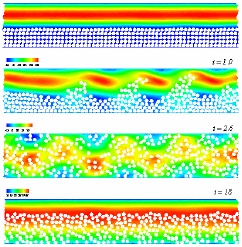Rheology & Modeling

We have investigated the rheology of fluid-particle suspensions in Newtonian and viscoelastic fluids. Our interest is largely focused on finding correlations for lift force in dense particulate flows that are analogous to the Richardson-Zaki correlation for drag. In this effort, we plan to use fully resolved simulation for flow configurations such as those shown in the figure below. These simulations can be used to extract model for lift force as discussed in Patankar, Ko, Choi & Joseph (2001). These models for lift can then be used in reduced-order simulation schemes. We are particularly interested in the problem of sediment transport, discussed below.
Sediment Transport
Numerical modeling is an important tool used in coastal morphodynamics and geomorphology to understand and predict future landform changes. Sediment transport plays a vital role in landform evolution in variety of circumstances. Some examples include river control and restoration, coastal protection, landslide prediction and mitigation (e.g. hillslope drainage), among others.
A fundamental understanding of sediment transport is crucial to simulate coastal processes. Landform changes due to sediment transport near the coasts, such as at the mouths of estuaries or at river drainage, can critically impact shipping routes. Sediment transport in the surf and swash zones and the long shore transport, directly determine coastline changes and beach erosion. Sediment transport in the ebb-tide delta system can critically impact shipping channels into coasts. The ability to plan the restoration, maintenance, and nourishment of coasts and coastal channels would be greatly enhanced by a predictive engineering simulation tool.
State of the art techniques to simulate sediment transport solve the fluid equations together with Lagrangian tracking of the sediment particles. In these methods, to be referred to as ‘reduced-order’ simulation (ROS) schemes, the hydrodynamic interaction force between the fluid and the particles is modeled. Successful ROS schemes for sediment transport should include both drag and lift forces to capture the fluid-particle interaction. The drag force acts on a particle in the direction parallel to the flow of the surrounding fluid, whereas the lift force acts in the direction perpendicular to the surrounding flow. The lift force must play a crucial role in the sediment transport process given the nature of the flow. Yet, in the present ROS schemes only the drag force is modeled well while good models for the lift force are still lacking. The thrust of our work is to resolve this issue.
Our objectives are three-fold
I. Perform fully resolved simulations of sediment transport and study the detailed dynamics of the sediment transport process. In fully resolved simulation techniques there are no force models used for the fluid-particle interaction. The flow around each individual particle is fully resolved and the coupled fluid-particle problem is solved.
II. Extract force models appropriate to sediment transport, specifically focusing on the lift force, from fully resolved simulations.
III. To include the new force models in reduced-order schemes resulting in a high fidelity simulation tool for sediment transport in realistic problems.
